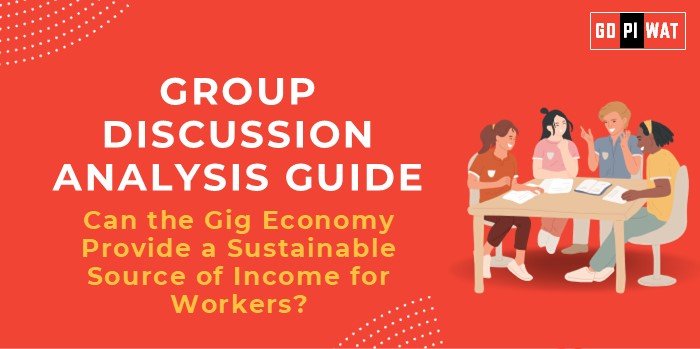📋 Group Discussion (GD) Analysis Guide
🌐 Topic: Can the Gig Economy Provide a Sustainable Source of Income for Workers?
🌟 Introduction
The gig economy, driven by digital platforms, has emerged as a dominant trend in the global workforce. While it provides flexibility and economic inclusion, the sustainability of gig work as a reliable income source remains a critical debate.
📊 Quick Facts & Key Statistics
- Gig Workers Worldwide: Expected to increase by over 30 million in the next year, reflecting rapid global growth.
- India’s Share: The gig workforce, 7.7 million in 2020-21, is projected to reach 23.5 million by 2029-30, highlighting its growing importance.
- Platform Economy Revenue: Ride-sharing platforms like Uber have disrupted traditional industries, leading to a 0.8% revenue decline in the taxi industry from 2016-2021.
- Income Volatility: Gig workers face irregular income, often without minimum pay, causing financial instability and challenges in meeting basic expenses.
👥 Stakeholders and Their Roles
- Governments: Establish labor laws to ensure fair treatment of gig workers.
- Corporations: Balance profit-making with worker benefits.
- Workers: Adapt to evolving market demands while advocating for their rights.
- International Organizations: Promote fair labor practices and global benchmarks.
🏆 Achievements and Challenges
- Achievements:
- Flexibility allows workers to choose tasks and schedules.
- Economic inclusion, especially for women and rural populations.
- Significant growth of platforms such as Swiggy, Uber, and Upwork.
- Challenges:
- Income Volatility: Workers often lack stable income, exacerbating financial stress.
- Benefits Gap: Absence of healthcare and retirement savings.
- Regulatory Uncertainty: Ambiguities in classifying workers as employees or contractors.
💡 Effective Discussion Approaches
- Opening Approaches:
- Fact-Driven Start: Highlight the projected rise of 30 million gig workers globally next year.
- Contrast Opening: Emphasize the flexibility of gig work against the backdrop of income instability.
- Counter-Argument Handling: Use data to acknowledge challenges while suggesting practical solutions like worker protection laws or universal benefits.
🔍 Strategic Analysis of Strengths & Weaknesses
- Strengths: Flexibility, economic inclusion, innovation opportunities.
- Weaknesses: Lack of financial stability, no standard benefits.
- Opportunities: Enhanced regulation, skill development initiatives.
- Threats: Monopolistic platform behavior, overregulation, income gaps.
🛠️ Structured Arguments for Discussion
- Supporting Stance: “The gig economy empowers individuals with flexible work options, addressing unemployment in dynamic ways.”
- Opposing Stance: “The lack of benefits and income stability undermines the sustainability of gig work as a reliable income source.”
- Balanced Perspective: “While the gig economy offers undeniable opportunities, addressing its systemic flaws through targeted reforms is vital for sustainability.”
🏫 Connecting with B-School Applications
- Real-World Applications: Assess the gig economy in relation to public policy or business model innovation.
- Sample Interview Questions:
- “How can public-private partnerships improve the gig economy?”
- “What regulatory changes can make gig work more sustainable?”
- Insights for Students:
- Explore the balance between flexibility and income security in evolving labor markets.


